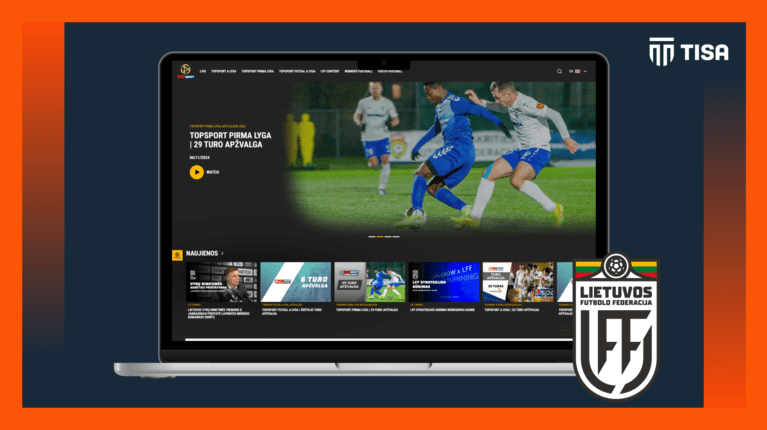Sports streaming is no longer one-size-fits-all. Executives who want to grow digital channels need to think beyond “the fan” and start thinking about fan segments.
A die-hard supporter in the stadium, a teenager watching highlights on TikTok, and an international fan following from abroad all have different expectations. An effective OTT platform has to meet them where they are.
Why Segmentation Matters
Segmentation is about more than demographics. It’s about behaviour and value. Research shows that avid sports fans consume about 32 % more weekly content than casual fans — 20.5 hours vs 14.5 hours (L.E.K. 2025). Treating both groups the same risks losing one or underserving the other.
The business case is clear. Half of households worldwide now watch sports via streaming, up from 44 % a year earlier (Kantar Q3 2024). Sports viewers also spend more: about $88/month on streaming compared to $64/month for non-sports viewers (InterDigital 2025). Fans are willing to pay if the product is tailored to their habits.
Key Segments to Consider
-
Die-Hard Fans
Loyal supporters who want full matches, replays, and behind-the-scenes content. They are also the most willing to pay for premium access and loyalty programmes. -
Casual Fans
They show up for big games or quick highlights. They value convenience, short content, and easy onboarding. For them, five-minute recaps may matter more than a full 90 minutes. -
International Fans
Diaspora communities and overseas audiences generate significant revenue. The NBA earns about $715 million annually from non-US media rights — over 20 % of its total (Streaming Media 2024). Multi-language features, subtitles, and flexible payment options are essential. -
Behaviour-Based Fans
These are segmented by behaviour: betting, fantasy, device use, or even following specific players. They respond best to personalisation and AI-driven recommendations.
Content Ideas That Work
Each group needs its own content mix:
-
Die-Hards: Premium subscriptions, full archives, exclusive documentaries, virtual meet-and-greets.
-
Casuals: Highlights, “top moments,” free-to-view teasers, social-first video.
-
International: Multi-language commentary, localised landing pages, time-zone-adjusted replays.
-
Behaviour-Based: AI suggestions (“You may also like”), bundles centred on star players, interactive polls linked to fantasy or match predictions.
Real-World Examples
-
Futbolas TV delivers multi-sport, multi-language streaming, showing how smaller federations can still target diverse audiences.

-
Barça TV+ offers content in Catalan, Spanish, and English — a clear nod to international fans.
-
Tapmad in Pakistan includes offline downloads, helping fans in regions with unstable connectivity.
-
LaLigaSportsTV goes beyond football with personalised recommendations across different sports.
These examples prove that multi-language, offline, and personalised experiences are no longer optional. They are baseline requirements.
Features That Enable Segmentation
An OTT platform designed for segmentation should include:
-
Multi-language support for both commentary and subtitles.
-
Offline downloads for markets with bandwidth issues.
-
AI-powered recommendations to group fans by behaviour.
-
Flexible monetisation models: subscriptions, pay-per-view, or ad-supported.
-
Unified fan identity through Single Sign-On, making it possible to connect streaming with ticketing and e-commerce.
The Role of Data Analytics
Data is the engine behind all of this. Tracking churn, ARPU, and LTV is essential:
-
Average churn across OTT sports platforms can reach 40–50 % annually.
-
Average Revenue Per User often sits around $80–90 per year, but can be much higher with upsells.
-
Lifetime Value averages $250–300 over about 3.3 years.
Analytics helps refine content. If casual fans drop off after three minutes, highlights need to be shorter. If international viewers in Asia watch most often in the morning, schedule push notifications accordingly. Segmentation without data is guesswork.
Read more about OTT Metrics Every Sports Organisation Should Track HERE
Strategic Takeaways
-
Start with fans, not features. Define segments first, then decide what features support them.
-
Localise for growth. International audiences represent major revenue potential, but only if language and payment barriers are removed.
-
Offer different journeys. Casuals need frictionless highlights; die-hards will appreciate depth and exclusivity.
-
Use data constantly. Monitor engagement, churn, and LTV to adjust strategies in real time.
-
Plan for scale. The sports streaming market is expected to reach $68.3B by 2030 [Grand View Research]. Building for segmentation now ensures competitiveness later.
Final Word
Designing OTT platforms for diverse fan segments is no longer a matter of innovation. It is a requirement. Fans are diverse in how they watch, spend, and engage.
The organisations that acknowledge this reality — and deliver tailored experiences backed by data — will be the ones who turn viewership into long-term value.
Ready to design an OTT platform that truly serves all your fan segments?
Contact us today to learn how STRIDE and Smart STRIDE deliver personalised, scalable, and data-driven streaming experiences.




